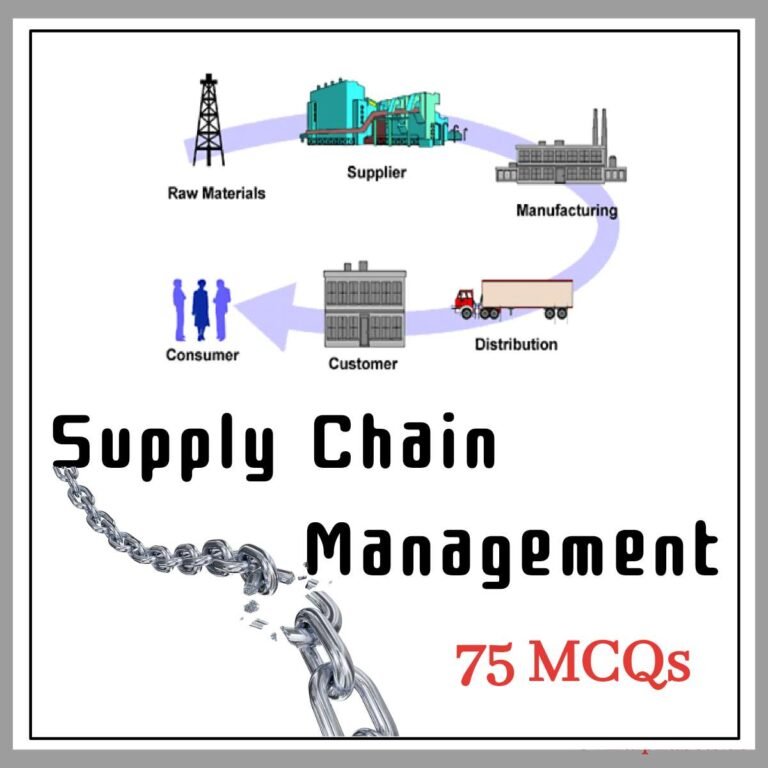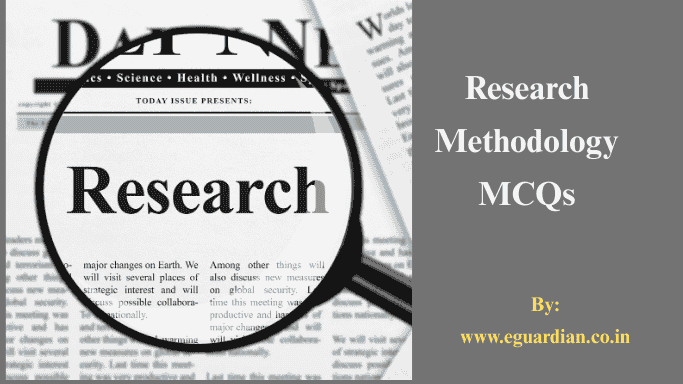If you are searching for Supply Chain Management MCQ Questions and Answers With PDF, you can get great help from my research.
I have collected a variety of questions and answers from different sources to help you prepare for your exams. I have also included a PDF document with all of the questions and answers.
75 Supply Chain Management MCQ Questions and Answers
1. Some of the quality techniques are ___, ___, and ___.
Ans. SPC, HALT, and HASS
2. Mention any one condition for the selection of sources.
Ans. Complying with the checklist consisting of supply selection criteria.
3. Reports on quality control, and inventory control systems are the criteria for which of the following factors?
a) Operating controls
b) Labour relation
c) Training aids
d) Reciprocal arrangements
Ans. a) Operating controls.
4. On what basis did Dickson formulate the evaluation factors?
Ans. Based on the survey done on purchasing agents and managers.
5. Mention any two of the SCM constructs.
Ans. Level of information sharing, quality of information sharing.
6. The main areas of SQM are Supply Chain Management and Quality Control. (True/False)
Ans. False. The main areas of SQM are Supply Chain Management and Quality Management.
7. ___, ___, and ___ help in identifying the competitive advantage.
Ans. Price, Quality, and delivery dependability.
8. ___ does not belong to QM practices. (Pick the right option)
a) Customer focus
b) Top management leadership
c) Process management
d) Internal lean practices
Ans. d) Internal lean practices.
9. Aligning goals is a long-term process. (True/False)
Ans. True
10. Mention one business model.
Ans. Six Sigma.
11. The risks involved in the operational performance environment are ___, exchanges of currency with foreign clients.
Ans. Trading relations.
12. Accepting third-party standards is a practice approach to designing a robust system. (True/False)
Ans. True.
13. The main aim of VRM is to free purchasers from the control of vendors. (True/False)
Ans. True.
14. VRM must enable customers to control their own ___.
Ans. Data.
15. Purchasing strategy defines goods and services that can be purchased with a specified amount of ___.
Ans. Currency.
16. The costs of goods and services are considered the most important___ of the purchasing process.
Ans. Determinants.
17. Tax maximizes the real income. (True/False)
Ans. False. Tax minimizes real income.
18. Purchasing is the process of acquiring all the materials needed by an organization in exchange for goods. (True/False).
Ans. False. Purchasing is the process of acquiring all the materials needed by an organization in exchange for funds.
19. The high-value products usually require ___.
Ans. Bids.
20. The goods that are received from the supplier go through ___.
a) Receipting process
b) Tender process
c) Payment process
d) Selection process
Ans. a) Receipting process.
21. ___ is defined as the increase in the demand variation in a supply chain from downstream to upstream.
Ans. Bullwhip effect.
22. Which among the following options is a reason for the bullwhip effect?
a) Demand forecasting
b) Strategic Partnership
c) Lead time reduction
d) Misguided capacity plan
Ans. a) Demand forecasting.
23. Variability increases with an increase in lead time. (True/ False)
Ans. True.
24. Most retailers place ___ orders during the shortage periods of products.
Ans. Inflated.
25. Uncertainty can be reduced by centralizing the ___.
Ans. Demand information.
26. ___ is defined as a management tool that is used to predict the uncertain future.
Ans. Forecasting.
27. Information sharing among various systems in the supply chain leads to effective forecasting. (True/False)
Ans. True.
28. In which among the following methods is experts’ opinions taken into consideration while creating forecasts?
a) Judgement method
b) Time-series method
c) Casual method
d) Market research method
Ans. a) Judgement method.
29. In the market research method, various past data are used to create the forecast. (True/False)
Ans. False. In the market research method, market testing or market surveys are conducted to understand the behavior of the consumers.
30. Reducing the ___ between forecast and actual demand should be the goal of an effective forecast.
Ans. Variation.
31. Effective sharing of ___ is very important to coordinate the various stages of the supply chain.
Ans. Information.
32. Manufacturing, ___, transportation, and ___ are the various systems involved in a supply chain.
Ans. Storage, the retail system.
33. In local optimization, one system in a supply chain finds out what is best for the entire system. (True/False)
Ans. False. In local optimization, each system optimizes its own operations without considering the effect of its operations on other systems in the supply chain.
34. The time taken from the moment the buyer places an order to the moment the buyer receives it is defined as ___.
Ans. Lead time.
35. ___ and ___ are the components of lead times.
Ans. Order lead time, information lead time.
36. Information lead time is the time taken to transport and produce the product. (True/False)
Ans. False. Information lead time is the time taken to process an order in a supply chain.
37. Lead time reduction is helpful to reduce the cost throughout the supply chain and it helps to improve ___.
Ans. Customer satisfaction.
38. Clear information regarding the status of the entire supply chain to reduce lead time is necessary. (True/False)
Ans. True.
39. Information can be used effectively to lessen the need for many of the tradeoffs. (True/ False)
Ans. True.
40. Large lot sizes lead to low inventory levels. (True/ False)
Ans. False. Large lot sizes lead to high inventory.
41. We can reduce ___ cost by aggregating the product movement. (Pick the right option)
a) Inventory cost
b) Transportation cost
c) Order cost
d) Warehouse cost
Ans. b) Transportation cost.
42. The complexity of supply chain management increases with an increase in ___.
Ans. Product variety.
43. We can improve ___ by reducing inventories, manufacturing, and transportation costs.
Ans. Customer service.
44. The purchase of machinery, equipment, or materials must go through the ___ department.
Ans. Purchasing.
45. A department places a document called requisition and gets approved by the authorized person in the ___ department.
a) Purchasing
b) Requisitioning
c) Finance
d) Warehouse
Ans. b) Requisitioning.
46. Many organizations prefer using ___ to manage their vendor relationship.
Ans. Vendor Relationship Management (VRM).
47. Many companies have realized that the Internet helps companies to move away from ___.
Ans. Push strategy.
48. The distribution strategies must be organized according to emerging ___.
Ans. Industrial trends.
49. Which of the following is a type of transshipment facility?
a) Warehousing
b) Cross-docking
c) Direct shipment
d) Distribution center
Ans. b) Cross-docking.
50. The warehouses which are being owned, managed, and controlled by both government and private agencies are called ___.
Ans. Bonded warehouses.
51. The objective of this centralized system is to minimize the cost associated with it for satisfying the service-level requirements. (True/False)
Ans. True.
52. The design and the facilities offered by ___ warehouses are dependent on the nature of the products that are to be stored.
Ans. Private.
53. The production and distribution decision forms the long-term forecasts in a pull-based supply chain. (True/False)
Ans. False. The production and distribution decision forms the long-term forecasts in a push-based supply chain.
54. ___ system reduces the bullwhip effect. (Pick the right option)
a) Distribution
b) Push-based
c) Pull-based
d) Supply chain management
Ans. c) Pull-based.
55. E-business strategies were developed with a view to meet some expectations like reducing cost, decreasing flexibility, and profits. (True/False)
Ans. False. E-business strategies increase flexibility and profits.
56. ___ is defined as the ability to electronically perform major commerce transactions.
Ans. E-commerce.
57. Push or pull-based systems come into play depending on the execution time of the process with respect to ___.
Ans. Customer demand.
58. ___are referred to as speculative processes.
Ans. Push process.
59. Partnerships that improve time to market, distribution times, or repair times help in ___
a. Adding technological strength
b. Adding value to products
c. Enhancing strategic growth
d. Strengthening operations
Ans. b) Adding value to products.
60. A partnership that enhances advertising or increases access to new ___ can be beneficial to firms.
Ans. Market channels.
61. Outsourcing is a process wherein a company assigns some of its ___ functions or processes to a third party.
Ans. In-house.
62. The benefits of outsourcing that are associated with decreased cost, cycle times, better customer perception, and approval are indirect benefits. (True/False)
Ans. False. The benefits of outsourcing that are associated with decreased costs and cycle times and better customer perception and approval are direct benefits.
63. Strategic alliances provide a great opportunity for organizational learning. (True / False)
Ans. True.
64. Firms with appropriate partnerships can improve operations by reducing ___ and operation cycle times.
Ans. System costs.
65. Asset-owning 3PL companies are termed fourth-party logistics service providers (4PL). (True / False)
Ans. False. Non-asset-owning 3PL companies are termed fourth-party logistics service providers (4PL).
66. Which of the following categories of 3PL companies provide standard logistic services like warehousing, packing, and distribution?
a) Standard 3PL companies
b) Service developers
c) Customer developers
d) Customer adapters
Ans. a) Standard 3PL companies.
67. The benefit of using 3PL in a company is that it allows the company to focus on its core competencies. (True/False)
Ans. True.
68. ___ is a business model in which parts or goods are delivered just when needed.
Ans. Just In Time (JIT).
69. The continuous-replenishment strategy is also called ___.
Ans. Rapid replenishment strategy.
70. Data accuracy can be maintained by using barcoding and scanning techniques. (True/False)
Ans. True.
Solved MCQ on research methodology pdf free download
Conclusion
Good ways to learn more about Supply Chain Management MCQs would be to read relevant books on the topic or to look for online blogs written by experts in the field.
Additionally, attending conferences or workshops on Supply Chain Management could also be beneficial in order to network with other professionals and gain insights into best practices.

